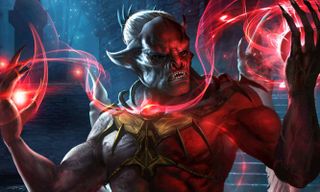
How Prophecy and Runes make for big comebacks
Perhaps the most interesting, and potentially controversial, design element of The Elder Scrolls: Legends is the Prophecy keyword, and the Rune system which activates it. The circle of health around your hero’s portrait is studded with five runes. Each time you pass a five damage threshold you lose one of these runes and draw a card. If that happens to have Prophecy on it, you get to play the card for free. Prophecy cards often have powerful effects attached—Piercing Javelin lets you destroy any creature, Portcullis summons a 0/9 with Guard—so being able to use them at no cost can lead to big swings.
The idea is clearly to ensure every deck has a built-in comeback mechanic. Card draw is one of the most powerful effects in any CCG, so the fact that it’s tied to losing life in Legends also theoretically helps mitigate the feeling of helplessness when you’re being stomped. (Interestingly, I noted that on one advice screen the game suggests including more Prophecy cards if you’re struggling against fast decks. Which makes me suspect brutal aggro is going to be just as much an issue here as it is in Hearthstone.)
What I don’t love about Prophecy is that it's the kind of RNG you can’t really play around. When you’re about to win but your opponent draws a ridiculous Prophecy card off his last rune draw, it feels terrible. What were you meant to do, not attack? I guess the answer is to control the RNG somewhat by ensuring the final blow does more than 5 damage.
If you love the more grown up vibe of the Scrolls universe, you’re not going to be disappointed.
It’s certainly an interesting system though, and one with plenty of potential. I just want to spend more time with it in a competitive setting before saying whether I definitely enjoy it or not. What I do like a lot, though, is the art style. It’s more muted, serious take on high fantasy than Hearthstone's art. Which isn’t to disparage Blizzard’s game, which is wonderfully poppy and over the top. But Legends benefits from greater consistency and detail. Each image is lush and fills its frame, and you could easily imagine they were all painted by the same person. Ultimately, the appeal of either is subjective, and it could be argued Legends is a little generic. But if you wind up trying Legends because you love the more grown up vibe of the Scrolls universe, you’re not going to be disappointed.
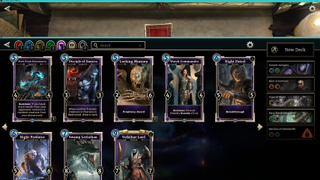
The lack of pizzaz hurts a little
Where Legends lags clearly behind Hearthstone's presentation is with the special effects. Spells in Legends aren’t nearly as flashy, and signature cards don’t tend to have really dramatic bespoke effects. Certainly, I haven’t seen much to rival the arrival of Lord Jaraxxus or Yogg-Saron on the board. That said, the overall production value feels worthy of the kind of big budget Bethesda must be throwing at this project. The menus are lovely and clean, and for the most part complex concepts are explained with minimal confusion.
What else do you need to know? There’s a 20-chapter story mode which serves as the tutorial. This comes complete with (once finished, presumably lavish) cutscenes, but honestly I blanked out what was happening. I just wanted to get on with busting packs and collecting cards. Speaking of which, 100 in-game gold buys you a single pack. Cards can also be disenchanted or crafted, which in Legends parlance is called Soul Trapping and Soul Summoning.
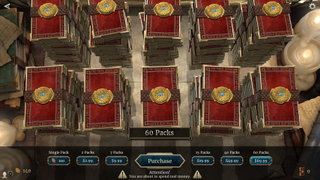
Unless you’re a dedicated free-to-player, chances are you’re going to throw down dollars to get your collection started. Buying with real money ranges from $2.99 for two packs, up to a bundle of 60 for $69.99—so, no surprise, very much on par with Hearthstone. Gold, crafting gems, and packs can also be earned by leveling up, completing daily quests, and playing in the Arena mode, but expect it to be slow going.
The biggest gaming news, reviews and hardware deals
Keep up to date with the most important stories and the best deals, as picked by the PC Gamer team.
Speaking of Arena, unlike Hearthstone, this mode can also be played against the AI. That’s an interesting tweak on the format. For the sake of my ever-rising sodium levels, it’s sometimes nice not to have to play real people. Particularly when you’re acclimating to a new game.
And therein lies my real worry with Legends. Do I have the brain space to follow and enjoy two big CCGs? Over the last three years I’ve sunk god knows how much time into Hearthstone, and I frankly dread to think how much money. I only hit Legend for the first time this year, and that’s having spent a huge amount of (enjoyable) effort watching streams and reading the Competitive Hearthstone subreddit in order to git gud.
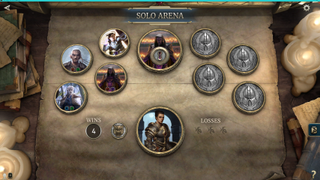
It’s going to hurt at first
But I suck at Legends. At least I do against real people. I have no sense of the meta whatsoever. I’m not sure what the curve of a 50-card deck should even look like. (Let’s face it, in Hearthstone most people net deck anyway.) My current decks are, I’m sure, absolutely terrible. So until I learn where the equivalent resource sites are for Legends, I’m going to struggle. Playing the beta I’ve also been struck by how easily I’d forgotten the dark days of being a new player in vanilla Hearthstone, when all I had was a crappy collection and a headful of terrible plays.
The real question now isn’t whether or not Legends is going to be good—I’m almost certain the answer to that is yes. But will it be good enough to lure a big enough community, so that there are the streamers and tournaments needed to make the scene thrive? And again, I think the answer is going to be yes.
As brilliant as Hearthstone is—and I consider it one of the games of my life—there’s a thirst for something new. I don’t think Legends is going to compete in terms of pure fun factor. It noticeably lacks the kind of moments created by a card like Reno Jackson in Hearthstone, and I’m not sure it will ever lead to a video series like Trolden’s wonderful Funny & Lucky Moments. But what Legends offers is the promise of a more detailed and strategic game, set in a world every bit as beloved as World Of Warcraft’s. I'm excited to see what happens when more people get to try it.
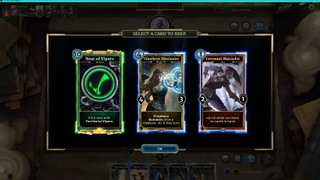
With over two decades covering videogames, Tim has been there from the beginning. In his case, that meant playing Elite in 'co-op' on a BBC Micro (one player uses the movement keys, the other shoots) until his parents finally caved and bought an Amstrad CPC 6128. These days, when not steering the good ship PC Gamer, Tim spends his time complaining that all Priest mains in Hearthstone are degenerates and raiding in Destiny 2. He's almost certainly doing one of these right now.
Most Popular



